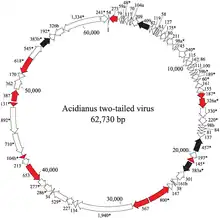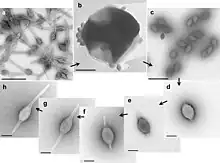Bicaudaviridae
Bicaudaviridae is a family of hyperthermophilic archaeal viruses. Members of the genus Acidianus serve as natural hosts. There is only one genus, Bicaudavirus, and one species, Acidianus two-tailed virus, in this family.[1][2][3] However, Sulfolobus tengchongensis spindle-shaped viruses 1 and 2 (STSV1 and STSV2) are regarded to belong to this family also.[4]
| Bicaudavirus | |
|---|---|
 | |
| Bicaudavirus | |
| Virus classification | |
| (unranked): | Virus |
| Family: | Bicaudaviridae |
| Genus: | Bicaudavirus |
| Species | |
| |
Structure

Viruses in Bicaudaviridae are non-enveloped, with lemon-shaped geometries. Genomes are circular dsDNA molecules of around 48–76 kb in length. High-resolution structure was determined by cryo-EM for Sulfolobus monocaudavirus 1 (SMV1) and a lower-resolution structure was determined for Acidianus two-tailed virus (ATV).[5] Virions of both viruses have helical symmetry, with continuous 7-start helices, composed of the single major capsid protein, forming both the tails and the spindle-shaped body. The major capsid protein structure and virion organization of bicaudaviruses are similar to those of archaeal viruses from the families Fuselloviridae, Thaspiviridae, Halspiviridae and Clavaviridae.[5]
| Genus | Structure | Symmetry | Capsid | Genomic arrangement | Genomic segmentation |
|---|---|---|---|---|---|
| Bicaudavirus | Lemon-shaped | Helical (C7) | Non-enveloped | Circular | Monopartite |
Life cycle

Viral replication is cytoplasmic. Entry into the host cell is achieved by attachment of the viral proteins to host receptors. DNA-templated transcription is the method of transcription. Diverse species of hyperthermophilic archaea from the order Sulfolobales serve as the natural hosts. Transmission routes are passive diffusion.[2] It has been demonstrated that certain members of the family, namely, STSV2 and Sulfolobus monocaudavirus 1 (SMV1), induce cell gigantism by blocking the expression of the cell division genes and arresting the cell cycle in the S phase.[6] The diameter of infected cells increases up to 20 times, resulting in 8,000-fold increase in volume compared to noninfected cells.[6]
| Genus | Host details | Tissue tropism | Entry details | Release details | Replication site | Assembly site | Transmission |
|---|---|---|---|---|---|---|---|
| Bicaudavirus | Archea: acidianus | None | Injection | Budding | Cytoplasm | Cytoplasm | Passive diffusion |
History
This family was first described by the team led by D. Prangishvili in 2005.[7][8]
The name is derived from the Latin word 'bi' and 'cauda' meaning 'two-tail'.
References
- Prangishvili, D; Krupovic, M; ICTV Report Consortium (7 June 2018). "ICTV Virus Taxonomy Profile: Bicaudaviridae". The Journal of General Virology. 99 (7): 864–865. doi:10.1099/jgv.0.001106. PMID 29877786.
- "Viral Zone". ExPASy. Retrieved 12 June 2015.
- "ICTV Report Bicaudaviridae".
- Krupovic, M; Quemin, ER; Bamford, DH; Forterre, P; Prangishvili, D (2014). "Unification of the globally distributed spindle-shaped viruses of the Archaea". Journal of Virology. 88 (4): 2354–8. doi:10.1128/JVI.02941-13. PMC 3911535. PMID 24335300.
- Wang, F; Cvirkaite-Krupovic, V; Vos, M; Beltran, LC; Kreutzberger, MAB; Winter, JM; Su, Z; Liu, J; Schouten, S; Krupovic, M; Egelman, EH (2022). "Spindle-shaped archaeal viruses evolved from rod-shaped ancestors to package a larger genome". Cell. 185 (8): 1297–1307.e11. doi:10.1016/j.cell.2022.02.019. PMC 9018610. PMID 35325592.
- Liu, J; Cvirkaite-Krupovic, V; Baquero, DP; Yang, Y; Zhang, Q; Shen, Y; Krupovic, M (2021). "Virus-induced cell gigantism and asymmetric cell division in archaea". Proceedings of the National Academy of Sciences of the United States of America. 118 (15): e2022578118. doi:10.1073/pnas.2022578118. PMC 8054024. PMID 33782110.
- Häring M, Vestergaard G, Rachel R, Chen L, Garrett RA and Prangishvili D (2005) Independent virus development outside a host. Nature 436, 1101–1102
- Prangishvili, D., Vestergaard G, Häring M, Aramayo R, Basta T, Rachel R and Garrett RA (2006) Structural and genomic properties of the hyperthermophilic archaeal virus ATV with an extracellular stage of the reproductive cycle. J. Mol. Biol. 359, 1203–1216